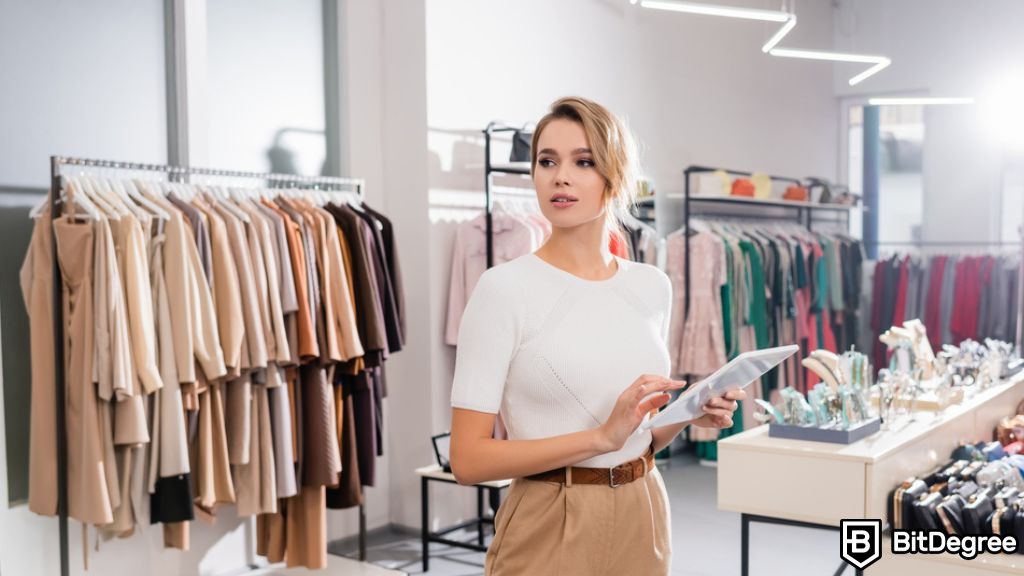Key Takeaways
- In retail, blockchain technology can transform the industry by improving transparency, security, and efficiency in the supply chain tracking, payment processing, and inventory management.
- When integrated with other technologies like virtual reality (VR) and augmented reality (AR), blockchain in retail can offer immersive commerce and engaging loyalty programs.
- While implementing blockchain in retail has many benefits, it presents several challenges, such as slow customer adoption and environmental concerns.
Free Airdrop Season 7 is LIVE! Answer fun questions or do simple tasks to earn rewards from the $30K BitDegree prize pool. Participate Now ! 🔥
Imagine a retail world where trust and transparency are built into the very foundation. This is the promise of blockchain in retail, a revolutionary approach that uses secure digital ledgers to reshape how products move, are tracked, and ultimately, how you experience the innovation as a customer.
Blockchain retail solutions go beyond just creating a verifiable record of every step in a product's journey; they can diversify payments and more – which we’ll discuss in this article.
To use multiple payments through blockchain, retailers and customers need a digital wallet to store cryptocurrencies. Ledger Nano X is an excellent solution due to its advanced security features, user-friendly interface, and support for multiple cryptocurrencies, making it an ideal choice for retailers looking to adopt blockchain-based payment systems.

Did you know?
Subscribe - We publish new crypto explainer videos every week!
What is Ethereum Classic & ETC Coin? (Animated Explainer)


Table of Contents
- 1. What is Blockchain in Retail?
- 2. Blockchain Retail Innovations
- 2.1. Enhanced Supply Chain Transparency and Efficiency
- 2.2. Real-Time Inventory Management
- 2.3. Diverse Payments and Financial Services
- 2.4. Decentralized Marketplaces
- 2.5. Improved Customer Experience
- 3. The Benefits of Blockchain in Retail
- 3.1. Benefits for Retailers
- 3.2. Benefits for Customers
- 4. Challenges and Considerations of Using Blockchain in Retail
- 5. Conclusions
What is Blockchain in Retail?
Before we dive into the exciting use cases of blockchain in retail, let's uncover the fundamental concept of this technology.
Latest Deal Active Right Now:Head to BitDegree Missions, gather as many Bits as possible & claim your stake of the $30,000 Prize Pool! Don't waste your time & start collecting Bits by completing Missions and referring friends.
Imagine a digital record book, not owned by a single entity, but shared and synchronized across a huge network of computers. This is the essence of blockchain technology, a secure and transparent way to store and track information.
At its core, blockchain is a decentralized, distributed ledger technology that securely records transactions across multiple computers, ensuring that each transaction is transparent, immutable, and verifiable. Here are some key characteristics of blockchain:
- No central authority. Blockchain operates on a peer-to-peer network without a central authority, distributing control among all participants and reducing the risk of a single point of failure.
- Public ledger. All transactions are recorded on a public ledger, accessible to all participants in the network, promoting openness and accountability.
- Tamper-proof and permanent records. Once recorded, transactions can’t be altered or deleted. Moreover, the use of cryptographic hashing makes the blockchain resistant to tampering and fraud.
- Cryptographic encryption. Blockchain uses cryptographic techniques to secure data and protect it from unauthorized access.
- Consensus mechanisms. Various consensus algorithms, such as Proof of Work (PoW) and Proof of Stake (PoS), ensure that all participants agree on the validity of transactions.
- Smart contracts. These are self-executing contracts with the terms of the agreement directly written into code. They automatically execute actions when predefined conditions are met.
Blockchain technology can be used in a broad range of applications[1], including electronic voting, distributed resources, crowdfunding, public record governance, and identity management. The real estate sector, for example, applies this technology to expand accessibility, reduce fraud risks, and enable fractional ownership.
In retail, blockchain's characteristics can help enhance supply chain transparency, improve data security, facilitate seamless transactions, and improve the overall customer experience.
Blockchain Retail Innovations
Blockchain in retail is transforming the way we shop and interact with the industry. These advancements are not only reshaping how transactions are processed but also providing new ways to engage and retain customers. Let’s see how the unique characteristics of this technology drive innovation in the retail sector!
Enhanced Supply Chain Transparency and Efficiency
Using blockchain in retail can ensure product authenticity and reduce fraud by providing a transparent and immutable record of a product's journey from origin to consumer.
When a product is manufactured, detailed information such as raw materials, source, production date, and manufacturer details are recorded on the blockchain. Each entry receives a unique digital signature and timestamp, creating an initial record that can’t be altered.
As the product moves through different stages – transportation, warehousing, wholesaling, and retailing – each transaction and handling step is recorded on the blockchain.
All participants, including transport companies and storage facilitators, need to add a new record to the blockchain after verifying the product's condition and details. This continuous updating creates a complete log of the product’s journey.
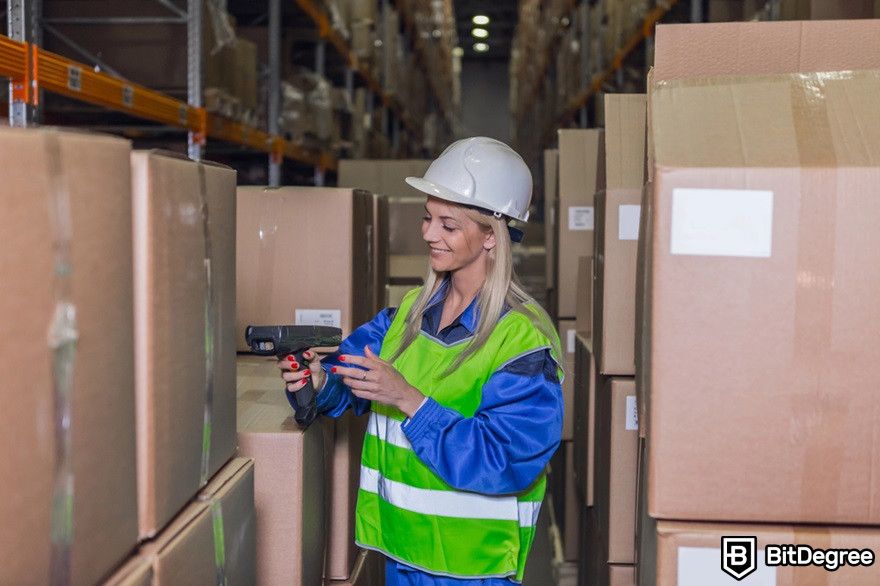
At the point of sale, consumers can access the product’s complete history by scanning a QR code or using an app linked to the blockchain. They can see detailed information about the product’s origin, its journey through the supply chain, and its handling at each stage.
With blockchain retail solutions, business owners can demonstrate their commitment to quality and authenticity and trace back through the supply chain if any issues arise. This is particularly important for high-value goods, luxury items, and perishable products where authenticity is crucial.
De Beers, the world-renowned diamond company, has built the Tracr blockchain platform. Tracr tracks diamonds from the mine to the retail store, ensuring that each diamond is conflict-free, authentic, and ethically sourced. This platform provides consumers with verifiable information about the diamond's provenance.
Real-Time Inventory Management
Implementing blockchain in retail offers various benefits for inventory management in the retail industry by providing real-time data.
Using smart contracts, the blockchain can automate inventory updates. The technology automatically records changes in real-time when a product is received, sold, or moved, ensuring accurate data reflection.
Retailers can also integrate blockchain with Internet of Things (IoT) devices like Radio Frequency Identification (RFID) tags and sensors that can automatically track inventory movements and update the blockchain ledger without human intervention.

As products are distributed to various retail locations, each movement is tracked and recorded on the blockchain. When a product is sold in-store or online, the blockchain ledger is updated, reflecting the sale and adjusting the inventory levels accordingly.
When inventory levels drop below a certain threshold, the system automatically generates replenishment orders based on real-time data. Such automation helps retailers maintain stock levels.
Modum is a good example. The Swiss company combines IoT sensors and blockchain to track environmental conditions, like temperature, and ensure accurate data for physical goods transactions.
When the goods reach the next transit point, the sensor data is checked against predetermined conditions in a smart contract on the blockchain. This contract confirms that the conditions meet all the required standards set by the sender, their clients, or a regulator.
If everything is correct, it triggers actions like sending notifications to the sender and receiver, processing payments, or releasing the goods.

Another popular example is IBM Food Trust. It integrates IoT devices like temperature sensors, RFID tags and Global Positioning System (GPS) trackers to monitor the condition and location of products in real-time.
The real-time data helps ensure compliance with safety and quality standards set by regulatory bodies, minimizing the risk of recalls and foodborne illnesses. RFID tags also help manage inventory levels by providing up-to-date information about the stock, reducing the chances of overstocking or stockouts.
Diverse Payments and Financial Services
Traditional payment methods like credit and debit cards involve several intermediaries, including banks, payment processors, and card networks. This can result in longer processing times, especially for cross-border transactions, as well as multiple fees that can reduce retailers' profit margins and increase consumers' prices.
Implementing blockchain in retail enables near-instantaneous transactions by removing intermediaries. This technology operates on a peer-to-peer network where payments are conducted directly between users without third parties like banks or processors.
Once a transaction is initiated, it’s broadcast to the network, where nodes validate it based on certain rules and consensus algorithms. This validation process can happen in real-time, reducing the time required to confirm transactions.
After validation, transactions are grouped into a block, which is then added to the existing chain of blocks (the blockchain). This process ensures that the transaction is permanently recorded and can’t be altered.
With blockchain, retail owners can also accept cryptocurrency payments.

Accepting cryptocurrencies has a lot of benefits. It opens up the market to global customers who prefer using digital money and removes barriers related to currency exchange and international payment processing.
Crypto payments can also be processed and confirmed quickly, often within minutes, as opposed to the hours or days required for traditional bank transfers or credit card settlements.
Moreover, retailers accepting cryptos can position themselves as innovative and forward-thinking, attracting tech-savvy customers and improving their brand image.
To accept cryptocurrencies with blockchain tech, retailers need a crypto wallet and gateway or exchange. A wallet keeps the money as crypto, while a gateway or exchange allows retailers to convert cryptos to fiat currencies easily.
Ledger Nano X is one of the most trustworthy crypto wallets. It supports various crypto assets like Bitcoin, Ethereum, and Litecoin. Its security is also top-notch, with features like a hardware ecosystem and a custom crime insurance policy.
If retailers are still hesitant to integrate crypto payments, they can start by applying stablecoins, such as Tether and USD Coin. Stablecoins can offer price stability[2], as they’re backed by real assets, including cash or cash equivalents.
Decentralized Marketplaces
Integrating blockchain in retail allows merchants worldwide to build decentralized marketplaces where they and buyers can interact and transact on a permissionless, self-executing platform without needing a middleman.
The essential functionalities, such as executing trades and releasing funds, are controlled by a program or smart contract instead of a person. Buyers and sellers agree to specific terms, and the transaction is be automatically executed by the smart contract when the terms are fulfilled.
Without intermediaries, decentralized marketplaces can offer lower fees, which can sometimes be not required at all. The rules in a marketplace can also be completely transparent and immutable. When you take a look at reviews, reputations, and dispute resolutions, decentralized marketplaces often outperform the centralized versions.
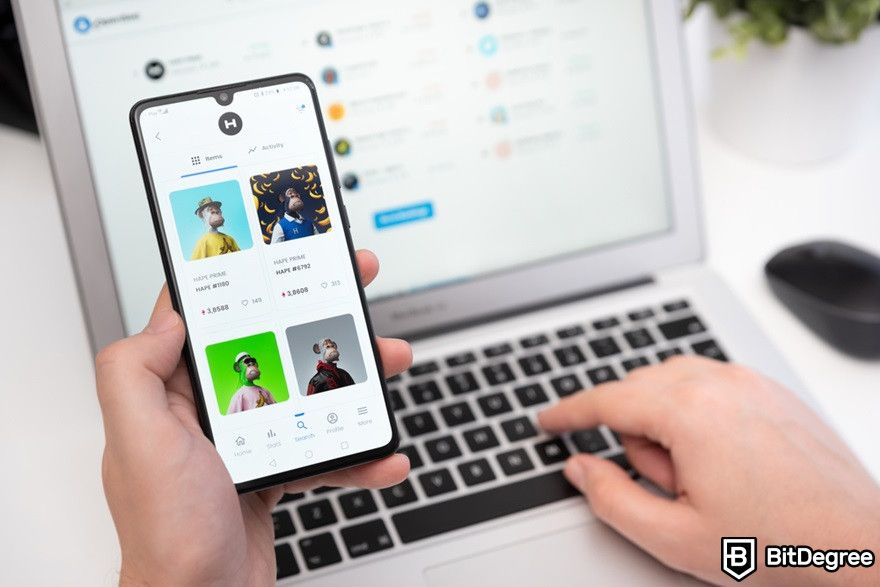
Decentralized marketplaces also create borderless commerce. These allow retailers to reach a global audience without the barriers imposed by traditional marketplaces. These marketplaces can operate on the internet and are accessible from anywhere in the world.
The decentralized nature of these platforms lowers entry barriers and provides opportunities for all businesses, helping small and medium-sized enterprises (SMEs) compete on an equal footing with larger companies.
OpenBazaar is one of the most popular and longest-running decentralized marketplaces. It started at a hackathon in Toronto in April 2014 as a project named “Dark Market”. The platform aims to provide transacting trades and eCommerce only, so there’s no need for miners or advanced consensus algorithms.
Its decentralized technologies such as blockchain and InterPlanetary File System (IPFS) enable direct and free transactions between buyers and sellers with no restrictions on use.
OpenBazaar also supports a wide range of cryptocurrencies as payment methods, from Bitcoin to Ethereum and Dash. This enables global transactions without the need for traditional banking infrastructure and allows users to transact in their preferred digital currencies.
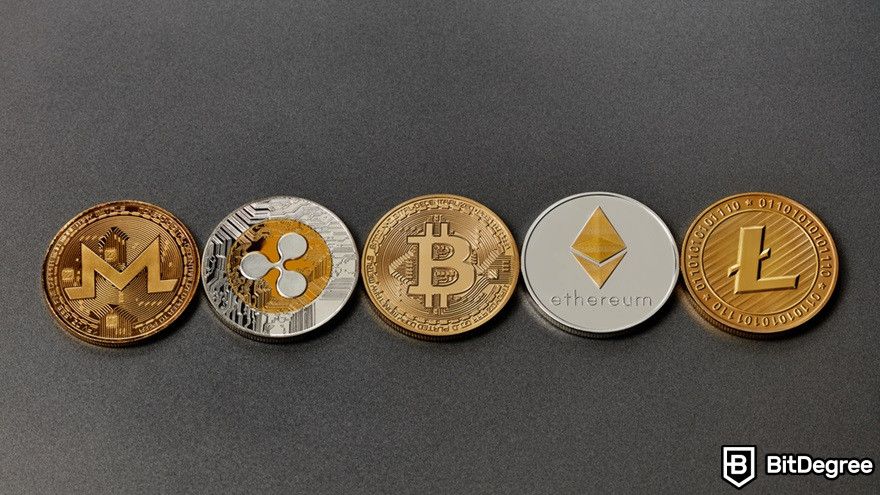
Another example is Syscoin. It has built-in marketplace functionality to offer decentralized marketplaces for various goods and services. This platform also provides solutions for supply chain management, loyalty programs, and secure tokenized payments.
Syscoin uses a hybrid approach, combining the security of the Bitcoin blockchain with the scalability of an additional blockchain layer called Syscoin Bridge. This two-tier system aims to provide robust security for assets while allowing faster transaction processing for everyday use cases.
Additionally, Syscoin supports both fungible tokens (like traditional cryptocurrencies) and non-fungible tokens (NFTs). This versatility allows for a wider range of applications, from loyalty programs and digital assets to unique collectibles and in-game items.

Did you know?
Subscribe - We publish new crypto explainer videos every week!
How to Pick the Right NFTs? (Animated DOs & DON'Ts)
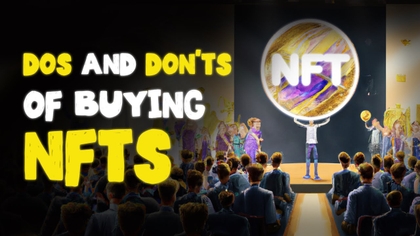

Improved Customer Experience
Implementing blockchain in retail helps create a clear ownership trail for every product, meaning retailers can easily streamline returns, exchanges, and warranties. Here's how:
- Automatic activation. When a customer purchases a product, the warranty can be automatically activated on the blockchain after purchase confirmation – no need for separate warranty registration cards or manual activation processes.
- Immutable proof of purchase. The blockchain record serves as a proof of purchase, readily accessible to both the customer and retailer. Retailers don’t need to worry about misplacing receipts when making a warranty claim or customers requesting a return or exchange.
- Automated eligibility checks. Smart contracts programmed with warranty details, such as coverage duration and terms, can automatically verify a claim's eligibility based on the product's blockchain record. This reduces the need for manual review and potential human error in assessing claims.
- Faster claim processing. With all relevant information readily available on the blockchain, retailers can speed up the entire claim process. Automated eligibility checks and secure access to purchase history can make approvals more efficient and get products repaired or replaced faster.
- Reduced fraudulent claims. The tamper-proof nature of blockchain makes it difficult to manipulate warranty and product information. The detailed transaction history ensures the item’s authenticity and helps prevent fraudulent claims for non-genuine purchases.
To visualize the benefits above, imagine a seamless return process where merchants simply scan the item, and the blockchain instantly verifies ownership and return eligibility – no more digging for receipts or waiting for manual approvals!
In retail, blockchain technology can also be used to provide immersive commerce. It’s a digital version of a brick-and-mortar store using virtual reality (VR), augmented reality (AR), and 3D visualization. This approach lets customers interact with products as they would in a physical space, creating an interactive and engaging online shopping experience.
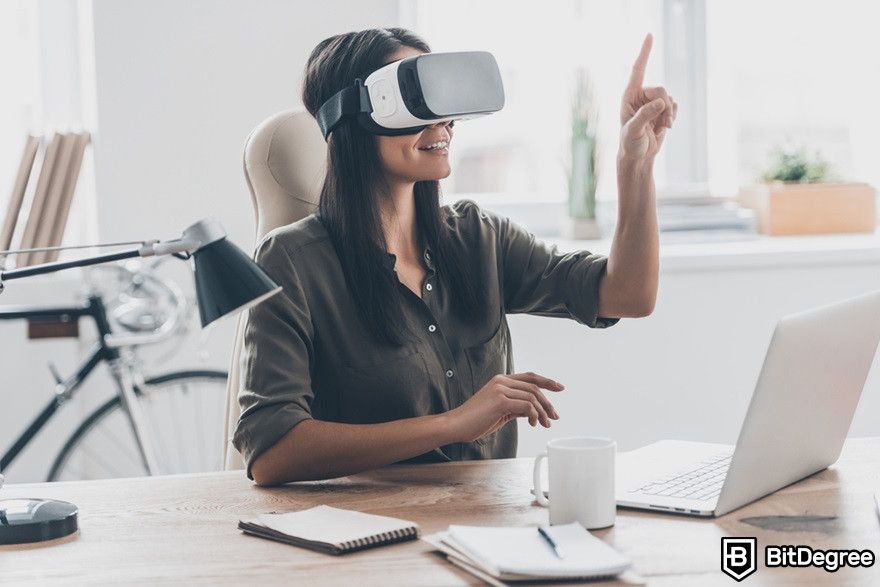
From the business perspective, a 2018 Gartner survey said that the virtual commerce experience helps increase sales by up to 30%.
Also, based on a 2022 Snapchat and Ipsos MORI report, over 50% of consumers are also more likely to purchase an item after experiencing it in VR.
Immersive commerce is inspired by video games, where players use virtual currencies to buy items.
Retailers can take those in-game – or in-store – currencies and put them on a blockchain as utility tokens. They can use the tokens as reward points, which customers can earn through purchases or interactions within the virtual store.
These tokens can be used to create a more dynamic and engaging loyalty program experience through:
- Frictionless rewards. Integrating tokens with the virtual store's wallet enables retailers to automatically award customers for purchases or interactions, eliminating the need for separate loyalty cards or points tracking systems.
- Gamified engagement. Similar to video games, retailers can design reward structures with tiered levels and challenges to encourage repeat visits or deeper engagement within the virtual store. Customers can only unlock exclusive rewards or discounts by earning tokens through certain activities.
- Increased value perception. The ability to redeem them for a variety of benefits, such as exclusive products or early access to sales, makes tokens offer more perceived value. They create a sense of exclusivity and motivate customers to participate.
- Better security. Blockchain-based wallets provide a secure and transparent way to store and manage tokens. Customers can be confident that their rewards are safe and accessible for use within the immersive commerce platform.
Tokend offers a platform for businesses to create their own tokenized loyalty programs. These tokens reside on a secure blockchain, providing increased security and flexibility to offer tiered reward structures, exclusive benefits, or even fractional ownership of rewards.
Moreover, this company offers a white-label platform, meaning businesses can customize the look and feel of their loyalty program while using its secure blockchain infrastructure. This allows for seamless integration with existing systems and branding.
A startup called Flexa also develops a blockchain retail solution in its payment systems that can integrate with loyalty programs. Its network can potentially be used to issue and manage tokenized loyalty rewards for merchants. Customers can earn these tokens through purchases or other program activities and redeem the points for various benefits.
Since Flexa integrates with existing point-of-sales systems, customers can redeem the loyalty points issued as tokens seamlessly at checkout – they won’t need separate loyalty cards.
The Benefits of Blockchain in Retail
The use of blockchain in retail offers several benefits for both business owners and customers, making operations more transparent, secure, and efficient.
Benefits for Retailers
With a transparent and immutable ledger to track products from the source to the consumer, retailers can ensure authenticity and reduce the risk of counterfeit goods.
Counterfeiting is a serious problem in the retail industry, with estimates suggesting it generates between $1.7 trillion and $4.5 trillion annually. If we compare the number to a country’s GDP, counterfeiting would be one of the world's largest economies, potentially exceeding Germany by a significant margin and ranking at least tenth globally, surpassing Canada's GDP.
Blockchain retail solutions provide a powerful tool to combat counterfeiting:
- Retailers can create a secure and transparent supply chain ecosystem where every product is assigned a unique digital identity.
- Consumers can verify the authenticity of products before making a purchase.
Additionally, implementing blockchain in retail increases efficiency in payment processing, inventory management, and product warranty or exchange processes. With smart contracts and integrations with technologies like IoT, retailers can automate various aspects of their operations, reducing manual errors and streamlining workflows.
Moreover, combining blockchain with other emerging technologies like VR and AR can make the shopping experience more immersive, interactive, and personalized. This might help retailers increase sales since most consumers become repeat customers after they get a personalized shopping experience.

- Secure and reliable
- Accepts fiat currencies
- Lots of trading options
- Reputable exchange
- Accepts fiat currencies
- Offers various trading options

- Fiat currencies - accepted
- Simple to use
- Accepts only the most trustworthy cryptocurrencies
- A leading cryptocurrency exchange platform
- Best for beginner investors
- Accepts fiat currencies

- Fully reserved and transparent
- Multiple tradable asset classes
- Over 300 supported cryptos
- Over 300 cryptocurrencies
- Secure & transparent
- Fully reserved
Benefits for Customers
Implementing blockchain in retail helps customers become more confident in the authenticity and integrity of the products they purchase.
With a transparent and immutable ledger of product information, customers can easily verify the origins, manufacturing processes, and supply chain journey of the items they buy. This transparency enables them to make informed and reliable purchasing decisions based on factors such as sustainability and ethical practices.
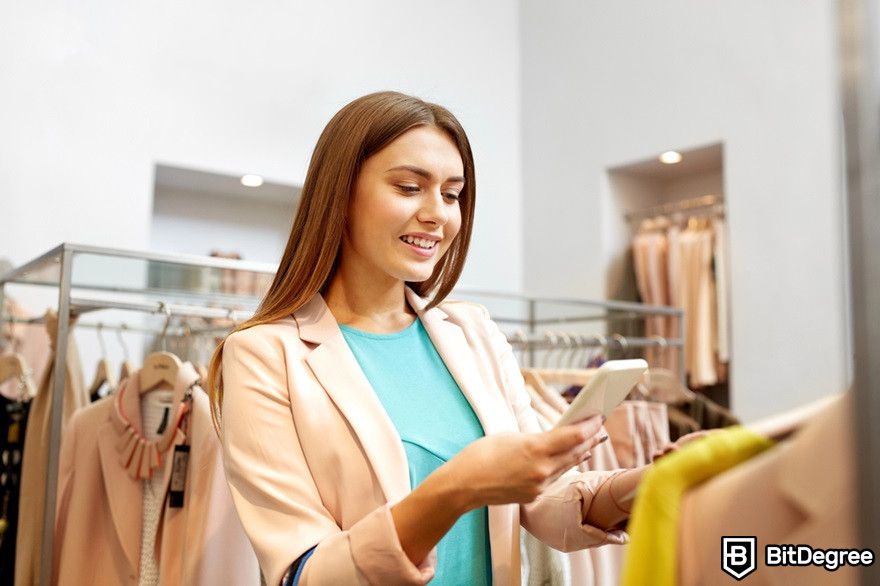
Additionally, blockchain-powered loyalty programs and rewards systems further boost customer confidence by offering transparent and fair incentives for their loyalty and engagement.
By the way, retail blockchain solutions might also potentially reduce the fees that customers need to pay when buying products. For example, cryptocurrency transactions typically have lower fees compared to credit card transactions, especially when it comes to international transactions.
Also, with cryptocurrencies, customers can sometimes avoid the fees associated with traditional payment methods, such as bank transfer fees.
Challenges and Considerations of Using Blockchain in Retail
While using blockchain in retail offers exciting possibilities, there are still challenges and considerations to address before its adoption becomes mainstream.
One of the biggest challenges is managing the initial investment.
Implementing blockchain solutions requires not only purchasing new technology but also potentially overhauling existing infrastructure to integrate these systems seamlessly. This can be a major upfront cost for retailers, especially for smaller businesses, that might outweigh the benefits in the short term.
Therefore, companies need to carefully evaluate the cost-benefit analysis before investing in blockchain in retail. Calculating the ongoing maintenance and support costs is also important to ensure the sustainability of blockchain implementations over time.
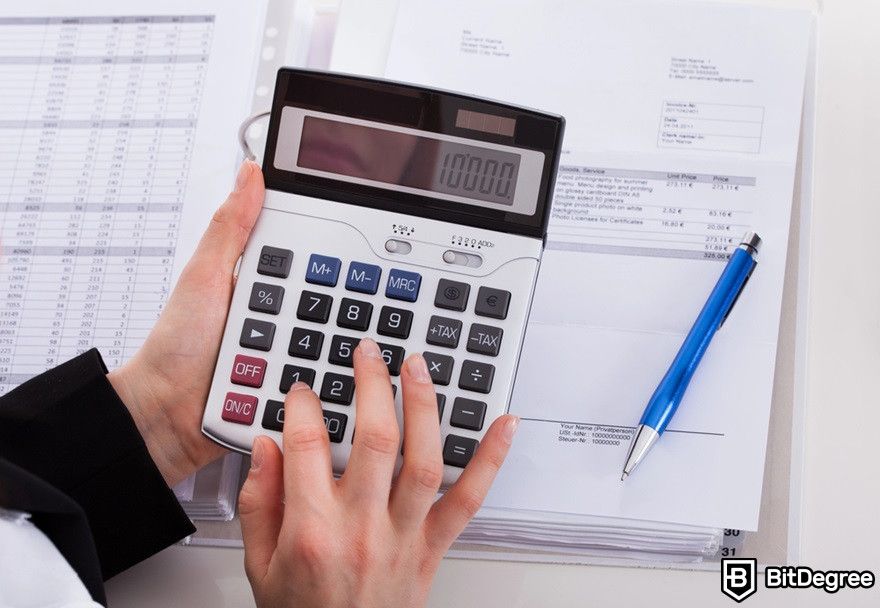
Another main challenge in adopting blockchain retail solutions is consumer adoption. Retailers must communicate the value proposition of blockchain-enabled services clearly and address any concerns or misconceptions regarding security, privacy, and usability.
To help increase trust and acceptance, consider highlighting how the technology benefits them. For example, emphasize how blockchain improves transparency in supply chains, allowing consumers to check a product’s authenticity and trace its journey from production to delivery.
Retailers also need to be aware of the environmental impact of blockchain, particularly the use of the Proof-of-Work consensus mechanism.
The Cambridge Bitcoin Electricity Consumption Index estimates the annual energy consumption of Bitcoin alone to be over 110 Terawatt-hours (TWh), comparable to the annual electricity use of a small country.
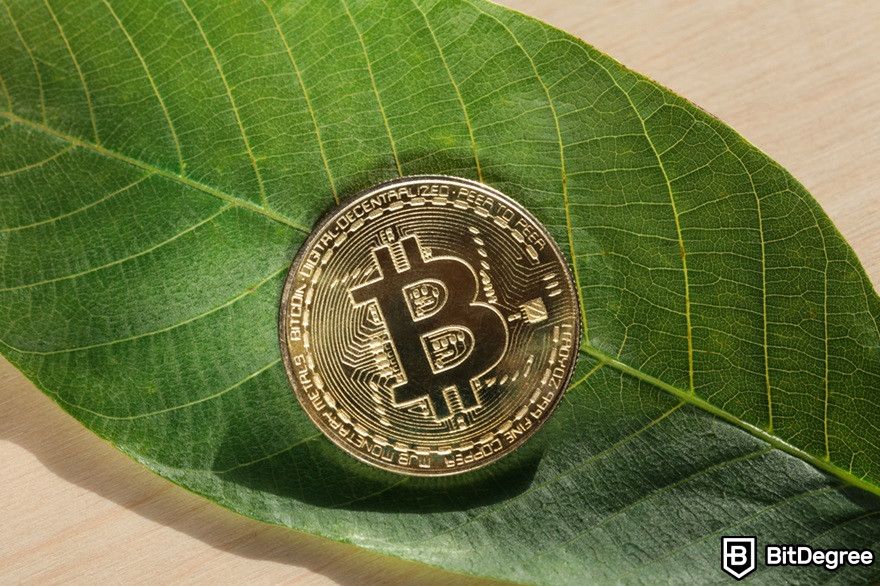
Many business owners increasingly prioritize sustainability in their operations. Therefore, high energy consumption associated with blockchain implementations may contradict these sustainability goals.
If retailers want to use blockchain technology in their operations, they should consider projects with alternative, more energy-efficient consensus mechanisms like Proof-of-Stake.
Conclusions
Implementing blockchain in retail can change how the industry works. The technology provides transparency, security, and efficiency across supply chains, inventory management, and payment processing. Moreover, it helps create more engaging customer experiences by offering immersive commerce and tokenization for loyalty programs.
In retail, blockchain also unlocks opportunities for companies to accept payments in cryptocurrencies like Bitcoin or Ethereum, which can be stored in secure digital wallets such as Ledger Nano X. This expands payment options for customers and opens up a global market, as cryptocurrencies are not tied to specific countries or currencies.
However, challenges such as costly initial investment, slow consumer adoption, and environmental concerns still need to be addressed if companies decide to implement blockchain in retail operations.
The content published on this website is not aimed to give any kind of financial, investment, trading, or any other form of advice. BitDegree.org does not endorse or suggest you to buy, sell or hold any kind of cryptocurrency. Before making financial investment decisions, do consult your financial advisor.
Scientific References
1. G.G. Ahmed, D.T. Mosa, L. Abualigah, et al.: ‘Emerging Trends in Blockchain Technology and Applications: A Review and Outlook’;
2. K. Zhang, T. Choi, S. Chung, et al.: ‘Blockchain adoption in retail operations: Stablecoins and traceability’.

